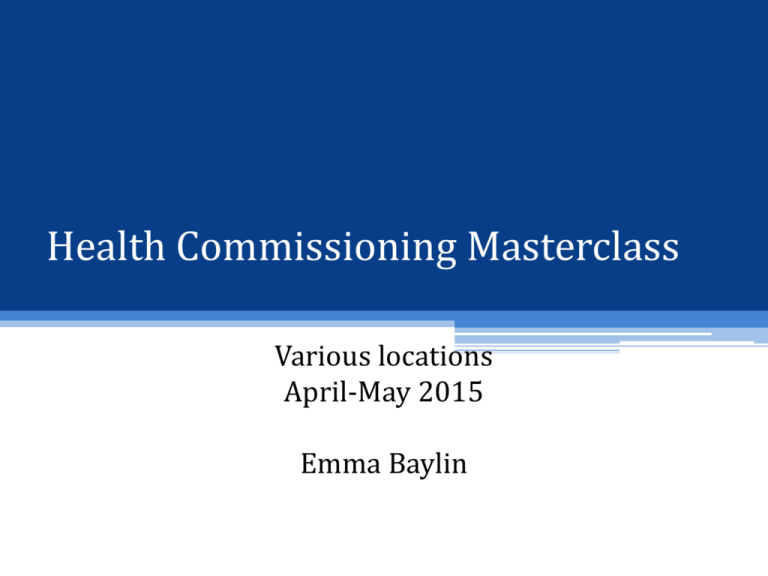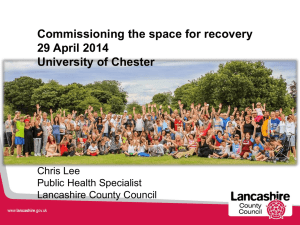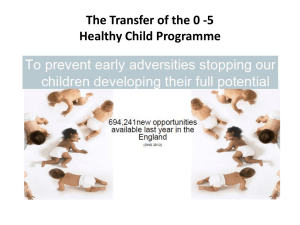Powerpoint Slides
advertisement

Health Commissioning Masterclass Various locations April-May 2015 Emma Baylin EXERCISE • Introductions • What is your experience with commissioning / tendering? • What have been the biggest challenges? • What are you hoping to get out of the day? By the end of the day you will : • Know more about the commissioning landscape and where tender opportunities might be available • Be more aware of how to use evidence and data to build a case for our work • Better understand how to be 'tender-ready' (e.g. in terms of systems and paperwork) • Feel more able to create/ respond to opportunities for partnership working and consortia development • Know more about other sectors’ drivers, motivations and culture National Secretary of State for Health and Department of Health Care Quality Commission Sub national Healthwatch England NHS England (the Commissioning Board) Public Health England Commissioning support Units 15 Public Health Centres (Leeds) 4 regional commissioning sectors (NHS North) Clinical senates and networks Area teams of NHS England Local Local authorities• Director of Public Health •Social services Overview & scrutiny Health and wellbeing boards •JSNA •JHWS •Commissioning plans Local Healthwatch Providers Clinical commissioning groups (may be more than one per local authority) Policy Context • Open Public Services • Personalisation and choice • Changing funding environment and structures • New commissioners • New investors • Outcomes focus • Integrated commissioning • New mechanisms (e.g. Payment by Results) • Localism 5 Year Forward View • Focus on "stronger partnerships with charitable and voluntary sector organisations" and an understanding of the diverse roles the sector can play in supporting healthy people and healthy communities. • Commitment to developing a shorter national alternative to the NHS standard contract, to grant funding and to multiyear funding. • Recognition of the value of carers, volunteers and the wider VCS- to support people gain more control of their own care, and the commitment to work more closely with the VCS. • Drive for more integrated care, between physical and mental health, between health and social care and between GPs and hospitals, between generalists and specialists. • NHS England is in agreement with the findings from Due North, that there's a need for stronger public health-related powers for local government- help communities take more control over their wellbeing. • Starting to break out of silo working and partner with DWP on work based health Evidence into Action • • • • Early Intervention and prevention Stronger partnership approach Addressing all wider determinants of health Mental and physical health are equally important to wellbeing • Reduce health inequality and ensure everyone is able to benefit • The importance of place and the strength of building on all of a community’s assets Voluntary Sector Strategic Review • • • • • • • • Co-design in commissioning Social value embedded in commissioning The building of local VCSE infrastructure Closer collaboration between statutory bodies & grant giving trusts. More support to VCSE organisations in demonstrating impact (against suitable metrics) Longer term funding A focus on reducing inequalities and improving the experience of the most disadvantaged A simplified grants programme based on a smaller set of aims EXERCISE – Fact or Fiction? • Commissioning is a separate process to providing grants • A grant is a lump sum of money that is essentially a gift. It does not have a legally binding status • Public bodies are allowed to give priority to local providers • Methods for monitoring performance & QA schemes are required in order to pre qualify for submitting a tender Answers • Commissioning is an overarching process, which includes needs analysis, service design, procurement, delivery and evaluation. If needs best met through providing a grant, then this is what will be offered • The funder can set out terms & conditions but a grant does not give rise to a legal partnership. With a contract the relationship is defined by contractual law • This would go against EU treaty principles that all contracts must adhere to. Although difficult for LA to specify need for local knowledge, VCSE’s may be able to best demonstrate indepth kowledge of user needs as part of their added value. • The invitation to Tender doc will set out what is required. In majority of cases, performance monitoring, QA systems will be required along with other polices, references, & audited accounts (3yrs) • Tenders will always be evaluated according to who can offer the cheapest price • The commissioning agency has the right to insist on the transfer of existing staff from the current service provider to the that of the successful bidder • Charities are allowed to apply for funding to deliver services outside of their objects and powers • Voluntary Sector can influence the commissioning process • Under EU rules, contracts can be awarded either on lowest price or most economically advantageous. This can take into account price, environmental and social criteria. Evaluation criteria & weightings must be set out clearly in the Invitation to Tender and used throughout tender evaluation • TUPE – legislation protecting the rights of employees currently delivering service. If TUPE is applied to a contract, them staff will be transferred across with costing impacts. You will need to consider pension & redundancy arrangements. • It can be tempting to follow a funding opportunity but the decision should always be governed by orgs mission, objects & powers. Changing a charity’s objectives is a legal process. Beware of mission drift! • VCS can influence by feeding in evidence about needs of communities & helping to shape service design. Dependant on establishing good relationship with funder (LA / CCG) 14 Challenging some assumptions… Procurement and Contracting are not the same as commissioning • Procurement is the process of acquiring goods, works or services from (usually external) providers / suppliers and managing these through to the end of contract. • Contracting is the process of negotiating and agreeing the terms of a contract for services, and on-going management of the contract including payment and monitoring. • These two elements or tools amongst others, form part of the commissioning cycle. They do not constitute all elements of the cycle. Commissioning Cycle 16 Exercise • Where within the commissioning cycle does the VCS have a role? • Where are you currently engaged? • What are the barriers? BREAK Data Sources http://datagateway.phe.org.uk/index.html http://www.phoutcomes.info/ http://healthierlives.phe.org.uk/topic/mortality http://healthierlives.phe.org.uk/ http://www.apho.org.uk/default.aspx?QN=P_H EALTH_PROFILES Commissioning for Value http://www.england.nhs.uk/resources/resourcesfor-ccgs/comm-for-value The role of NICE • To identify good practice using the best available evidence • To help resolve uncertainty for the public, patients and professionals • To reduce variation in the availability and quality of practice and care NICE Guidance and Quality Standards A set of systematically developed recommendations to guide decisions for a particular area of care or health issue Evidence Guidance Research studies - experimental and observational, quantitative and qualitative, process evaluations, descriptions of experience, case studies Quality Standards A NICE quality standard is a concise set of statements designed to drive and measure priority quality improvements. NICE Quality Standards • Define high-quality, cost-effective care across a disease, condition or clinical area • Presented as a set of specific, concise statements that: • act as markers of high-quality, cost-effective patient care; • are derived from the best available evidence; and • are produced collaboratively with the NHS and social care, along with their partners and service users. “As a provider of care services, I can “As a provider ofQS caretoservices, can use NICE quality use NICE ensure Iand standards to ensure that and demonstrate I provide high demonstrate I provide highthat quality qualitycare, care,based based on on the the best bestavailable availableevidence. They help me in my auditing to improve the auditing quality of services I evidence. They help me in my provide, support in discussions with to and improve the me quality of servicesI have I commissioners.” provide, and support me in discussions I have with commissioners.” "As a user of care services, they support me in my choices about “As a practitioner working in who provides care for me, and in social care they: give me knowing what to expect from a reassurance that the care and good quality care service." support I provide is based on the best available evidence; help me with practical support in my decision-making; and keep me up to date." “As a commissioner, I can use NICE quality standards to commission the best quality, most cost-effective care, and to support more integrated health and social care services in my area.” NICE Quality Standards and guidelines for social care Topic Guidance QS Health and wellbeing of looked after children Published Published Supporting people to live well with dementia Published Published Autism in children and adults Published Published Mental wellbeing of older people in care homes Published Published Managing medicines in care homes Published Published Challenging behaviour in people with learning disability May 2015 2015/16 Home care July 2015 2016/17 Older people with multiple long-term conditions Sept 2015 2016/17 Children’s attachment Oct 2015 2016/17 Transition between health and social care Nov 2015 2016/17 Transition from children’s to adults’ services Mar 2016 2017/18 Child abuse and neglect May 2016 2017/18 Mental health problems in people with learning disability Oct 2016 2017/18 Local Government Briefings • Concise information on cost-effective and evidence-based solutions for local government, public health and, from April 2014, social care • For local authorities and their partner organisations in the health and voluntary sectors, in particular those involved in Health and Wellbeing Boards • Demonstrate potential role of NICE guidance as the basis of solutions to public health issues and problems at a local level • Introduction • Key messages • What can local authorities achieve • What is effective • Examples of good practice • Developing an action plan • Costs and savings • Background to recommendations • Support • Other useful resources • Derived from existing guidance • Web-based format with links to other sources of information – but also printable www.nice.org.uk/lgb NICE Into Practice Guide • Web based guide to help health and Who is it for? social care organisations use NICE guidance & quality standards to achieve a This guide is for anyone who is … high quality of care in local settings • Suggests what an organisation can put in. place, and what staff can do, to use NICE guidance & quality standards to improve outcomes and get the best value for money • Includes helpful tips, links to other resources and shared learning examples of how other people have used NICE guidance and quality standards • a commissioner or provider of health or social care • responsible for ensuring that evidence-based guidance is put into practice by their organisation • involved in quality improvement • involved in planning, delivering and scrutinising care services • leading on implementing a specific piece of guidance • using a quality standard to improve quality across a team or service. Recommended examples from Guide the QIPP collection NICE Into Practice Advice and resources to help you: •establish how services/local pathways compare to NICE quality standards •locally prioritise quality improvement •support changes in services that fall short of the NICE quality standard •develop an action plan (or commissioning plan) •assess cost & service impact, and develop a business case •measure quality improvement •evaluate, provide assurance and share success If you want to ensure that services you provide or commission are safe, effective, good value for money and striving for continuous quality improvement then this guide is a good starting point. www.nice.org.uk/intopracticeguide NICE Shared Learning Would you like to understand how other people implement NICE guidance or use NICE quality standards in practice? Are you willing to share your own experience with others? The NICE Shared Learning Database - part of the Local Practice Collection - contains hundreds of searchable examples covering a wide range of topics. To search for examples or to make a submission, see the NICE Local Practice Collection at www.nice.org.uk/sharedlearning NICE is particularly keen to hear your experience of using quality standards to improve the commissioning and/or delivery of high quality care. EXERCISE How would you use the data outlined to help your conversations with commissioners or during the tendering process? i.PHE ii.C4V iii.NICE LUNCH Three tips on how to influence commissioners (who I always think of as the customer, as they have the money!): Chriss Dabbs Unlimited Potential • Listen – don’t talk! It is what the commissioner is buying that is important (not what you are selling). It is about what the commissioner wants, making life easier for commissioner and the commissioner’s perceived needs. Key questions for the commissioner: What is the main problem you want to solve? How might we help you? [And getting them to the point when they ask themselves, “Why would we not use them?” – rather than “Why would we use them?”] • Make your case in terms, formats and language that are most comfortable for the commissioner. • Always offer more than the commissioner is asking for – added value, better outcomes, etc. EXERCISE • What makes a good sales pitch? Good selling is about: • Building the right relationships • Being clear about what differentiates you/your services • Adding value by the way you engage • Being able to evidence your capabilities • Listening and being responsive to your customer • Reaching mutual agreement • WIN-WIN-WIN 39 Partnership working and Consortia Why consortia? Barriers Facing Small Organisations • The procurement process (long, complex, expensive) • Unable to find out about opportunities • Contracts are too big • Pre-qualification • Cashflow 41 Consortia – overcoming barriers • Scale • Development of specialist tendering and contract management infrastructure • Greater bargaining power • Adding value at the frontline • Building capacity 42 Different Contracting Forms • • • • • Provider Managing Agent Managing Provider ‘Super Provider’ Joint venture 43 Provider Commissioner Provider Provision of Services 44 Managing Agent Commissioner Managing Agent Sub-contractors Provision of Services 45 Managing Provider Commissioner Managing Provider Provision of Services Sub-contractors Provision of Services 46 Managing Agent/Provider Contract top slice Percentage of contract to pay for management of sub-contractors: • Performance • Quality • Financial management 47 ‘Super Provider’ Provider Provider Provider Provider Provider Provider 48 Super-provider: How does it work? • Incorporation to form new legal entity • Providers become members of this company • Hub and spokes operating model 49 Hub & Spokes operating model 50 Ownership & Management Structure 51 Exercise • What are challenges in developing consortia? • What key points must you keep in mind? • What extra barriers / benefits come from partnerships with i) VCS ii) Public Sector iii) Private sector Key stages of collaboration • 1. Identify Think carefully whether collaborative working is appropriate for your organisation. Be clear about your own goals and understand your strategic environment. This will help you in identifying and approaching your partners. • 2. Plan Work closely with your partners to develop your collaboration. Draw up shared aims, structures and agreements and develop positive relationships. • 3. Implement Manage the collaboration effectively with a strong action plan and communications plan. Prepare yourself for any possible frustrating times ahead by building in effective problem solving and understanding some of the key challenges that may arise. • 4. Review Review your collaborative experience and use what you've learned to prepare a forward strategy. To bid or not to bid? Show of hands Tender Strategy • • • • • • Just interested or all in? Partner up? Decide who’s in charge? Check points Plan for procurement outcomes (good or bad) Be brave Mission-Money Matrix on mission majority activity prime target (love it here) stay out! less57 money – off Commercial mission Masterclass, Day One proceed with caution more money To bid or not to bid? • • • • • • Mission Risk Management Capacity Collaboration Financial Legal 58 – Commercial Masterclass, Day One Key Stages in a typical procurement process Deciding on a procurement procedure Advertising the contract Prequalification Inviting tenders End of the Contract Monitoring Awarding the Contract Evaluating Tenders Pre-qualification questionnaire • • • • • • • basic details of your organisation financial information business activities references from previous clients insurance details details of any recognised quality management certificates copies of your health and safety, equal opportunities and environmental management policies • professional and business standing of the organisation and its directors/trustees, for example, details of any criminal records or bankruptcies • examples of relevant experience • first indications of how you propose to deliver the service. Completing your tender Exercise • 2 points that you need to consider before completing a tender application • 2 points to keep in mind while completing a tender application • 1 ‘Top Tip’ Benefits and Value for Money • Core ▫ You must deliver the core specification. ▫ Demonstrate how, and your experience of delivery. ▫ You must do this at a competitive rate. • Winning ▫ What is the additionality you can offer? ▫ What can you identify for free? 63 Tender Ready!! 10 The 10 Steps Create a ‘Tender’ Desk 7 8 Policies and Standards 4 Responding to Technical & Quality questions 5 Introduction to Do your research Tender Documents – who buys what? 1 Commitment, passion, drive 2 9 3 Understand the Know your changing landscape business – why us? Presenting Professional tenders 6 Foster good relations to influence commissioners Where to look • • • • Public Tenders www.publictenders.net Contracts Finder www.gov.uk/contracts-finder Blue Light www.bluelight.gov.uk Funding Central www.fundingcentral.org.uk This course has been brought to you by:







